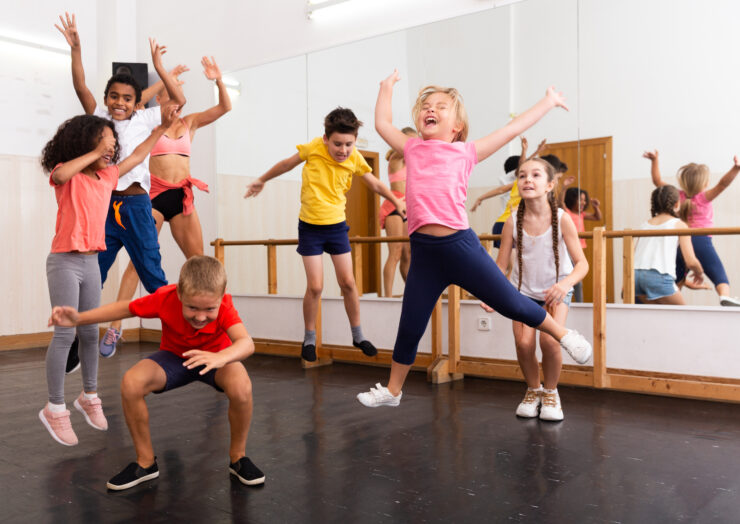Might creative dance lessons improve children’s learning?
How dance can help children think creatively, with potential benefits for learning

Creativity seems to decline during the primary school years as children learn to conform to structured schooling. But creativity helps students solve challenges within and outside the classroom, and will be crucial in the future because of the rapid growth of technology and the changes this will bring in the workplace. Creating environments that harness children’s capacity to innovate would help them navigate new kinds of job opportunities.
“Creating environments that harness children’s capacity to innovate would help them navigate new kinds of job opportunities.”
As a teacher who specialises in yoga and dance movement therapy, as well as a child development researcher, I wondered whether creative dance lessons might help children think creatively in the classroom. Creative dance involves improvisation, open-ended instructions, and a non-judgmental approach, which can open the door to experimentation and creativity. While other forms of dance may be learned by copying and practicing movements that are then used to create new works of art, in creative dance, dancers generate and express their own ideas and responses through new movements.
Three movement principles that help children learn creative dance
• Space: moving on different levels (high/middle/low), in different directions (forward/backward/sideward), or along pathways (straight/zigzag/curvy).
• Effort: moving at different speeds (fast/slow) or with different weight (heavy/light).
• Relationships: moving in unison with someone else, following another’s lead, or mirroring another dancer.
How to teach creative dance to children
I recommend structuring each lesson in the same way to make it predictable, and playing simple music, without lyrics, to help children focus. You might start with a 5-minute introduction, giving children props to use or introducing a movement activity, followed by a 5-minute warm up incorporating that lesson’s movement principles. Next, encourage children to explore movements based on three words, such as “run, stop, spin”. As you guide the children through each word, they learn to apply the three movement principles – space, effort, and relationships.
Next, give the children choices for performing the three words, including a variation. Open-ended prompts help children explore. Ask “Can you run on a curvy path?”, “Show me any kind of spin on a high level”, or “How would you do that differently?” Always keep the focus on the children. Never provide explicit instruction or visual demonstration – if necessary, ask a child to demonstrate. At the end of the lesson, invite the children to share their choreography with their peers and give each other feedback. A choreography rubric helps to ensure that the feedback is positive and constructive.
Does creative dance boost children’s creativity?
In a study with researcher Iroise Dumontheil, I taught a 10-week creative dance curriculum to 6- and 7-year-olds as part of their physical education lessons, using the approach described above. For purposes of comparison, I taught yoga to a different group of children, and a third group continued with the physical education lessons taught by their regular teacher.
After the 10 weeks, the children who had participated in the creative dance and yoga lessons moved more creatively than those whose physical education lessons had remained unchanged. We measured this by asking each child to move in as many different and unusual ways as possible, either between two lines or along a beam between two hoops. To measure their creative thinking, we also presented each child with a piece of paper containing five blank shapes, and then asked them to draw any object, expression, or event they could think of using those shapes. Interestingly, children in the creative dance group – but not children in the yoga group – were better at creative thinking than the children who had continued with their regular physical education lessons.
“Creative dance seems to encourage children to spontaneously follow their creative impulses.”
Six months later, we followed up with the children and found that all three groups had improved their creative movement and thinking. They were now on the same level, with no differences between the groups. This suggests that the creative dance lessons temporarily accelerated the children’s development in creative thinking and movement, while the yoga lessons temporarily accelerated their development in creative movement. More lessons in creative dance and yoga might be required for sustained benefits. Interestingly, children who had scored lower on creative thinking before starting the creative dance lessons seemed to benefit more from creative dance than their peers; they saw a bigger boost to their creative thinking.
Creative dance seems to encourage children to spontaneously follow their creative impulses. Schools could capitalise on this link by supporting teachers in learning to teach creative dance in a way that uses open-ended problem-solving prompts, gives children choices, and supports peer feedback. This might, in turn, help children solve the challenges they face in and out of the classroom.
Footnotes
The creative dance lessons were inspired by the work of Ann Green Gilbert and Dance Education Laboratory. I would like to thank the participants, class teachers, and research assistants who helped collect data for their important contributions to this study.
Working with the Matilda Centre for Research in Mental Health and Substance Use and the CREATE centre at the University of Sydney, I am currently researching pretend play and its impact on mental health and wellbeing in preschool-aged children, with the goal of improving how pretend play is facilitated in early childhood settings. For more information about this project or to become involved, please contact me at [email protected].
